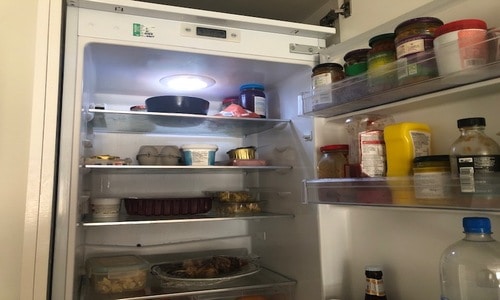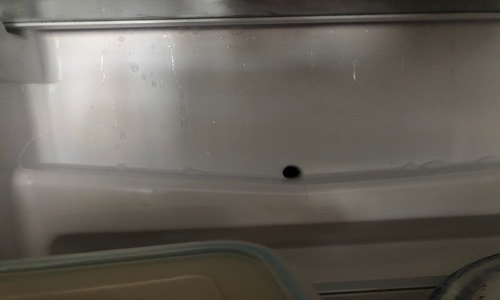Fridges are what you use to keep your food fresh and safe to eat, so it’s really frustrating to open the door and find that your fridge has become moldy, meaning you’ll have to throw away any moldy food and then get to cleaning.
So, what are the most efficient ways of cleaning the mold out of your fridge, and even more importantly, how can you stop it from coming back?
In this article, we will be covering how to effectively clean your fridge, your fridge seals (gaskets), as well as how to prevent mold from coming back, so if you want to have all your fridge mold questions answered, we’ve got you covered, so keep reading.
To clean mold from a fridge, mix one tablespoon and baking soda with four cups of water to form a solution. Gently scrub the affected area with the solution and allow it to fully dry before placing the food back into the fridge. You can also place a box of opened baking soda to prevent mold from forming.

Can a refrigerator with mold be saved?
Before we get into how to clean and prevent mold in your refrigerator, you may be tempted to throw the whole fridge away if you think the problem is too bad to be fixed. So, can you save a moldy fridge, or do you need to buy a new one?
The good news is that under most circumstances, you do not need to throw a fridge away if it has mold. It can usually be cleaned thoroughly to make it safe to use again. However, should you find that the problem is persisting even after a deep clean and preventative measures have been taken, there may be an issue with part of the refrigerator that will either need to be repaired, or replaced, or may even warrant purchasing a new one altogether.
Should you throw away all the food in a fridge with mold?
Unfortunately, if you have found mold in your fridge, it is best to replace all the food that was in it. The reason for this is that even if there were no visible signs of mold on other items, there may still be mold spores that are not visible to the naked eye.
If left, these spores can begin to reproduce and multiply once again.
The exceptions here are foods that are still in their packets and have not been opened. It is possible to wash the packets or containers to ensure that mold spores are removed and place them back in the fridge once it has been thoroughly cleaned. Of course, you will need to make sure you have cleaned the products in warm water and used a non-toxic substance such as detergent to ensure any mold residue has been removed.
You will need to be absolutely certain you have cleaned the products properly though, and if you are even slightly uncertain, it would be best to throw the items away.
How to clean mold off fridge gaskets
The gaskets (rubber seals) around the door of the refrigerator are the most common areas to find mold accumulation. This is more common in older fridges that may have rubber seals that have begun to perish and are allowing cool air to escape and warm air to enter. When this cool air mixes with room temperature air, moisture will condense around the seal.
The mixture of moisture, temperate climate, food residue, and minimal air circulation are all that mold needs in order to thrive, creating the perfect environment for it to grow.
There are several highly effective methods you can use to clean your refrigerator gaskets of mold, I’ll explain each in detail below.
Hydrogen peroxide method
- Clean the area using a rag and warm water to remove the majority of visible mold
- Fill a spray bottle with undilated hydrogen peroxide
- Spray the affected area and allow the solution to sit for 15-20 minutes
- Use a cloth to wipe the area clean
- Once dried, use a mixture of warm water and dish soap to wipe away any hydrogen peroxide residue.
Vinegar method
Vinegar’s acidity level (having a PH of 2.5) makes it an excellent method for cleaning mold off a refrigerator gasket. It is also readily available in stores, is cost-effective, and can be used to clean many other areas of the home.
Here’s the method to use for cleaning fridge gaskets.
- Clean the affected area using warm water and dish soap to remove the majority of visible mold
- In a spray bottle, create a solution of 1/2 cup of distilled white vinegar to 1 1/2 cups of water
- Spray the affected area and leave to sit for 5-10 minutes
- Wipe down the gasket with a damp cloth to remove the vinegar solution
There may be a slight scent of vinegar left in your fridge for some time after using this solution. If you want to avoid this, you can once again wipe down the area with a cloth and a solution of dish soap and warm water to improve the smell. Again, make sure the fridge is completely dry before closing the door.
White vinegar isn’t always the easiest thing to get hold of, so I’ve added a few links below that will take you to the Amazon store so you can pick some up. The good news is, it’s a really affordable and environmentally friendly way to kill mold.
Baking soda method
Baking soda is an excellent cleaner that not only helps to remove mold from a refrigerator gasket but also helps to remove the odor that mold can produce. It comes heavily recommended by many appliance experts as it is an alkaline substance with a PH of 9. This means it will not cause the rubber of the gasket to perish.
Here is the method for using baking soda to clean mold from refrigerator gaskets.
- Wipe the area clean of visible mold using a water and dish soap solution
- Mix 4 cups of water to 1 tablespoon of baking powder
- gently mix the solution
- Apply to the area with a rag and gently clean the gasket
- Allow the cleaned area to air dry or use a paper towel to mop up any excess liquid
Bleach
You may have heard that using bleach is a great way to kill mold, and whilst this may be true, it should not be used on rubber fridge seals. Bleach is a powerful cleaning product, but it can be corrosive and therefore can damage the rubber, causing it to perish. Far from fixing the problem, using bleach on rubber seal could increase the likelihood of you needing to clean your fridge more often, and may even require you to purchase replacement seals.
How to clean the rest of your fridge of mold
Whilst we’ve established that mold most commonly forms around the gaskets of a fridge, it can form within the fridge itself. To clean your fridge and make sure it’s safe to use, try the methods below.
Baking soda
If there are large areas of mold buildup in your fridge, using baking soda (also called bicarbonate of soda), can be a cheap and effective way to clean it.
Sprinkle baking soda all over the shelves and trays, and use an abrasive sponge to rub the powder across all surfaces. Then use a solution of warm water and dish soap and spray each surface. Use a paper towel to mop up and dry the inside of the fridge.
It is not advised to use bleach or other chlorine-based products to clean the inside of a fridge, as it can slightly damage and etch the surface. Below are again a couple of links to the Amazon store to make life a little easier.
Soap and warm water
Not all cleaning methods have to be complicated, using a solution of warm water and dish soap is also highly effective for removing mold from the surfaces of your refrigerator.
Here is the method.
- Remove all shelves, drawers, racks, etc from the fridge and clean them using the same warm water and dish soap solution you will use for the fridge and allow them to dry.
- Use an abrasive sponge to work the warm water and dish soap solution into the surfaces on the fridge.
- Ensure the entire fridge has been cleaned as spores can travel.
- Either allow the fridge to air dry or use a dry cloth to wipe and dry the surfaces
Why do refrigerators get black mold?
Refrigerators create an ideal environment for mold to thrive if they are poorly maintained. Usually, the cold temperature would make it difficult for mold to grow, however, as we have discussed, poorly maintained gaskets can make it harder for a fridge to maintain its temperature.
Mold also requires a lack of sunlight and food to eat, something a fridge has plenty of!
Mold also requires moisture to grow, and when levels of moisture build up, they will tend to condense on the interior walls.

You will usually find a small hole towards the back of your fridge to allow this water to be collected and removed through the back of the unit.
This hole can become easily blocked by debris, and if the water cannot be drained, the moisture levels increase, making it more likely that black mold will grow in your fridge.
Fridges help keep food fresh by being at a temperature that makes bacteria and molds hard to form and breed. So, issues regarding the internal temperature of the unit can play a large role in mold formation. Ensuring that the door has been closed properly, the thermostat is functioning and the doors aren’t being opened too frequently will lessen the likelihood of mold formation.
What about white mold in Fridges?
White molds can also grow on the food products in a fridge such as cheeses, meat products, and vegetables as well as the internal surfaces. White mold (often made up of aspergillus, Cladosporium, and penicillium species), requires the same circumstances to thrive as black mold, being, in dark, cool environments with a food supply and lack of airflow.
White mold can cause health problems for people with certain conditions such as asthma, allergic reactions, respiratory infections, and nausea amongst others. It should therefore be removed as quickly as possible by cleaning the refrigerator using the methods described above and unpackaged food thrown away.
How to prevent mold buildup in your fridge
Ensuring a fridge doesn’t become moldy in the first place is far easier than having to deal with a smelly and moldy one. There are several options available to you to make sure you don’t have to worry about dealing with this frustrating problem at all.
Maintain the fridge
Ensure that the thermostat is working correctly, check all rubber seals for perishing, and make sure the fridge drain hole is clear of obstruction so no water pools at the back of the fridge.
Put cooked foods in airtight containers
Whilst freshly cooked foods should be placed in a fridge for storage fairly quickly after cooking to ensure the window for bacteria to grow is as small as possible, steam coming off the foods can increase the overall moisture levels. Therefore, it is best to put these items into an airtight container so that no steam can escape.
Clean it regularly
By keeping your fridge clean, you take away the food sources for mold and bacteria to feed off. Without a constant food supply, mold simply cannot live and so making sure you perform a deep clean of the unit once a month should help to lower the risk of mold formation.
Add baking soda
We have discussed the benefits of using baking soda to clean mold from a fridge, but it can also be used as a preventative measure. Keeping an open box or pot of baking soda in your fridge will allow it to absorb any excess moisture. Not only will this make it harder for mold to grow, but it also works as a fantastic way to absorb odors.
How long does it take for mold to grow in a fridge?
Mold can grow within 24 to 48 hours if given the appropriate circumstances, being, warm, dark, moist environments with adequate food supply. In most cases, your fridge should not provide this environment, however, if there is a technical fault with the unit that does not keep the temperature low, mold could begin to grow within several days.
Is it safe to use a fridge that has mold?
All molds can be harmful to health whether or not a person has additional allergens etc, so as soon as mold formation is spotted, it should be removed and the fridge cleaned thoroughly with all fresh and uncovered food thrown away.
When to replace moldy refrigerator gaskets
After cleaning, if the seal on your refrigerator shows any signs of perishing (crumbling or cracking), then the seal needs to be replaced immediately. If you find that the doors will not close properly and leave a gap, they may have warped, this will not allow for a constant temperature and so they will also need to be replaced under this circumstance.
How do you keep mold out of an unplugged refrigerator?
Mold can very easily form in an unplugged refrigerator, as the temperature will remain constant, and there may be moisture and food residues the mold can feed off. To keep an unplugged fridge clear of mold, use the following steps.
- Clean all surfaces, racks, and drawers in your fridge using warm water and dish soap
- Allow the fridge to air dry for several days before putting it into storage
- Keep the door open to create a constant flow of fresh air and allow sunlight in
- Place a box of opened baking soda in the fridge whilst it is in storage to absorb any moisture
- Store the refrigerator in a dry location, preferably with natural sunlight
Conclusion
Mold in a refrigerator can be an annoying, unpleasant, and costly occurrence that could result in you needing to replace food or even the unit itself.
Fortunately, in most cases, the mold can be removed safely, and if the appropriate measures (listed in this article), are taken, you can prevent mold from returning.
I hope this article has helped, and if it has, please feel free to share it or link back to it if you think it would help others.

